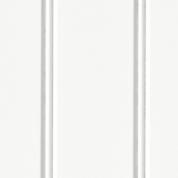BeadBoard

"May they grace the space … for another hundred and ten."
The bead board first appeared as an inspiration. We'd started removing that regrettable seventies wallpaper and sheetrock to find bead board beneath. Original to the house, much of it remained in near pristine condition. The Muse and I considered this find to be one of those serendipitous symbols that simply insist upon catching our attention, a once in a lifetime opportunity we 'daresn't' ignore, so we changed the plan. Rather than simply refinish the walls with newer sheetrock, we'd use the bead board to create wainscoting which would highlight the kitchen and its half bath while showcasing some of the place's heritage, a prototypical Bright Idea. "I know, we could put on a show!" ©2018 by David A. Schmaltz - all rights reserved
Like in the old Andy Hardy movies, turning the derelict barn into a Broadway theater for a single amateur performance turned out to be a tad bit more work than the originating Bright Idea anticipated, but the kids channel their considerable talent as well as their all-consuming delusion to, in short time, create a stage worthy of a Busby Berkeley production. The performance turns out to be a big hit and the producer who just happens to be in the audience, signs Andy and his company to a long-run on The Great White Way. It's The American Way, how generations of unknown nobodies have made it to the big time. Why should our kitchen be any different?
Two and a half months later, I'm painting the last two finish coats on that once secreted bead board. Once removed from its original placement, we painstakingly removed each nail, puttied the resulting holes, sanded off the rougher faces, and washed then primed each board. There were a hundred and ninety seven of them once we'd discarded the obvious bummers. Since it was the rainy season, each stage began with moving the piles of boards from the covered front porch to the sawhorses set up in the back yard (or the unfinished kitchen, depending upon that day's weather.) We primed them inside, ringing the dismantled kitchen with freshly primed boards before dutifully stacking them painted face to painted face and carting them back around the house to their front porch lair.
Top coating came in four distinct stages because it was a day's work to apply each top coat to half the boards. I had drying space for only half the boards at a time. I'd carry stacks of boards around the house to the driveway paint shop, arranging them by length, before commencing to painting, starting with the shortest boards, leaning each finished piece against one of the two sides of my makeshift paint shop, short boards beneath longer boards in recursive rows, which I'd leave to dry overnight. Rainy days separated painting days, each rain storm requiring another migration back to the covered front porch. It took all of ten days to finally finish applying two top coats to all the boards.
Construction caught up sometime thereafter. The Muse and I had returned to Colorado for a respite while the boards went up on the walls. I think we had one board left over of the ones that turned out to be useable, a fact that we of course interpreted as another sign from The Gods that we were certainly engaged in their work. Once mounted on the walls, the boards needed caulking, a job I wisely left to our contractors. I tried to caulk once and I expect to be able to wear that fleece jacket again in fifty years or so. I insisted upon applying the final coats to the mounted boards, a task I'd hoped my pre-painting would enable me to avoid, but the caulked seams insisted upon more paint, two coats, for a total of five. I've touched each board dozen of times between harvesting, cleaning, painting, and carting, two more coats of top coat shouldn't kill me all that much, even though this final touch demands penitence only achieved on my knees.
The finished product, now crowned with fine chair rail, looks better than we'd expected. We had not shied away from the unavoidable rustic look of repurposed boards, figuring that this might humble the pretensions the rest of the design presented. The boards seem elegant even in their rougher surfaces. They seem proud to still be prominently displayed after a hundred and ten years since they were first hung on those walls. May they grace the space with no surprise contract to relocate to any Great White Way for another hundred and ten.


